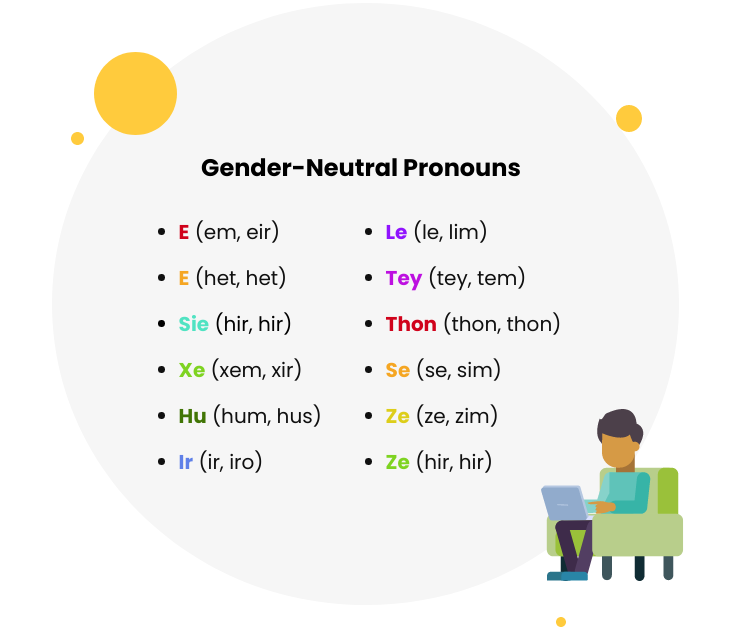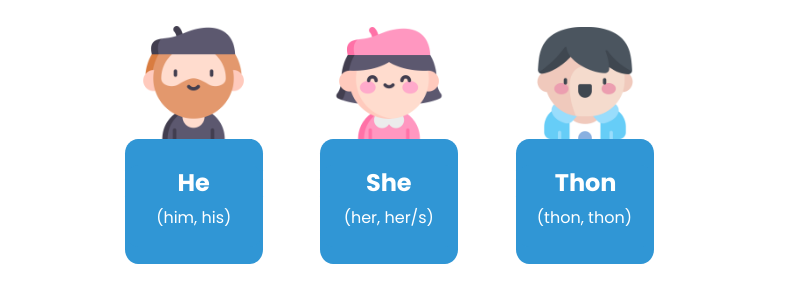Often when you’re completing academic writing, especially essays, you need to use pronouns. In academic writing, the use of the word you is unacceptable. You can find yourself in a sticky situation, deciding upon gender-neutral pronouns in your academic writing.
How can students deal with it?
In most situations today, it seems more tolerant to use they. Using only masculine or feminine pronouns, you might offend a non-binary person (someone who doesn’t associate themselves with male or female genders exclusively).
That’s why the singular they is an optimal choice for academic or any other type of writing. Moreover, it’s more compact and comfortable to pronounce—you don’t have to list both female and male pronouns.Nonetheless, you may want to read this article to see the history of the issue and the gender-neutral pronouns list. Our team collected different pronouns that people use in the English language to express the neutral gender.
🔹 Frequent Questions
Nowadays, our society has become more and more tolerant towards and understanding of gender differences. Thanks to LGBT activists, gender-neutral pronouns have cemented their position in daily life.
For example, Facebook now allows its users to choose “custom” in the field for gender. According to ABC News, the social media platform uses 58 options: agender, genderqueer, trans, pangender, etc.
Even more importantly:
Harvard University allows students to choose among several proper pronouns on their registration forms. With such options as ze and they, the university has made real progress in this area.
Gender-neutral pronouns are a topic that is changing a lot all the time. That’s why you may have a lot of questions.
Discover the most frequently asked questions to give you the newest information on the topic.
- What Is Gender-Neutral?
You can often hear this phrase from LGBT supporters. But what does it mean? According to the Cambridge Dictionary, gender-neutral means relating to people regardless of gender, neither to men or women in particular.
The goal of gender neutrality is to avoid discrimination. The central idea, consequently, is to eliminate all the differences between the genders. - What Does Non-Binary Mean?
People are generally familiar with two genders: male and female. But non-binary is a term used to describe those who aren’t male or female or who are both male and female.
Remember:
You can’t always identify someone else’s gender. Neither their appearance, behavior nor sexual orientation are reliable signs of gender. That’s why you should be careful when choosing the words you use to describe people.
Many supporters of gender-neutral expression write on social media, something like, “Ask me about my pronouns.” Pay attention to such appeals. - What Is a Third Person Pronoun?
A third-person pronoun is a word that is used to talk about another person. For example, she, he, and they are typical examples of third-person pronouns. - Why Do We Use Pronouns? What Does a Pronoun Do?
Pronouns are an essential part of almost any language. They are used to take the place of a noun. - Are They a Singular or Plural Pronoun?
They is a plural pronoun. It’s used to describe two or more subjects:
Jimmy and Tom stayed in the class until 4 PM. They worked on a project.
It’s also used to set gender neutrality in the form of the singular they:
One should complete their studies before dinner. - When to Use They?
Singular they is a gender-neutral pronoun that is officially accepted by many institutions. In academic and juridical writing, it’s stylistically correct to use the singular they when talking about people.
Here’s an example:
If a person comes in a room, you can describe that action in the following way:
They opened the door and came into the room. - What Is a He/She?
He/she is a typical use of a third-person word. It is often used in academic writing to show that the author doesn’t know the gender of a person. - What Are Preferred Pronouns?
Nowadays, society accepts the idea of non-binary gender. So, everyone is free to choose the pronoun that they associate themselves with. The pronoun a person chooses would be their preferred pronoun. - What about Ms., Mrs., and Mr.? Are there gender-neutral options for those?
This is an important question. How can we talk about gender neutrality if every letter we write must be ended with a binary word: miss, missus, or mister?
This is also something that feminists are fighting against. These titles show gender and reveal the marital status of a woman, which is unnecessary and outdated.
There are a lot of supporters of eliminating these titles. That’s why several new titles have been proposed:- Ms.—it’s a female title to add before a woman’s surname. It doesn’t show marital status but does sound respectful.
- This title was later developed into Mx.—a version that was created for gender-neutrality purposes. Many LGBT members of society use this title when unaware of the person’s preferred pronouns.
- What is the Associated Press Stylebook?
The AP Stylebook is a stylistic guide that contains grammar and punctuation rules. It was developed by journalists for other writers and includes editorial commentaries on terminology, photo captions, formatting, and bibliographies.
All in all:
In this article, you’ll learn about the modern ways of using third-person pronouns. Now you can distinguish between gender-neutral pronouns in academic writing and communication.
Custom-writing.org advises you to be careful when choosing pronouns to stay respectful and avoid hurting anyone’s feelings. You can recognize a pronoun by its goal in the sentence. Try to use the same pronouns that people identify themselves with.
🔴 Academic Use of Gender Pronouns
While society is struggling with the choice of universal identifying pronouns, students still have to accomplish lots of academic writing. And with any academic work, it’s essential to stick to rules and norms, even under constantly changing conditions.
For example, let’s say that your goal is to talk about animal welfare. You begin with: “Once a person adopts a pet…” And here comes the trouble right away. “He,” “she,” “they”—which one should you use? Are there any neutral pronouns? Or is it necessary to rewrite the sentence altogether?
There are several typical uses of pronouns in such cases.
- When you’re talking about males only, use masculine pronouns:
When one decides to grow a beard, he should prepare to spend some money. - When you talk about females only, use feminine pronouns:
On Mother’s Day, every woman gets a discount on her favorite cosmetics brand. - When genders are mixed, show the gender-neutral identity in one of these three ways:
Once a person adopts a pet, he or she should fill out a document.
Once a person adopts a pet, s/he should fill out a document.
Once a person adopts a pet, they should fill out a document.
The last option is the most popular. It is called the “singular they” and is used in connection with the singular person. It was already in use in the late 1300s, and now it has gotten its popularity back.
With all its advantages, they is still a plural pronoun, which confuses many speakers and writers. Of course, specialists say that it doesn’t sound weird, just like the single word you is okay both for singular and plural forms. But still, the following question interests a broad range of people:
Are there any other non-gender pronouns?
The answer is: yes.
There’s a whole gender-neutral pronoun list—with lots of options to choose from.
🔵 Gender-Neutral Pronouns List
There’s been a long history of the neutral pronouns’ development. Thanks to the LGBT community, we now have a nice list of them.
And you can read them right now! Who knows—maybe in just a year or two, we will all be using one of these options.
Here are some examples with their nominative, accusative, and possessive forms:

This is just a short personal pronouns list, but there are many more examples. You can find all of them online.
If you’re interested in seeing these words in action, here are some examples of Alice in Wonderland with the pronouns changed to some of those mentioned above.
But if there are so many variants, why do we still not use any of them?
The main reason lies in the lack of unity between the supporters of gender-neutral pronouns. Because there are so many options, society hasn’t settled on just one of them. Moreover, new variants are constantly being developed. That’s why it’s not a bad idea to use an online word rewriter to make your text better.
As people haven’t stuck to one option, it’s been difficult to try to popularize any of them. However, a couple of variants have been more successful than others. We’re going to discuss them in the next section.
🔶 Transgender Pronouns Thon and Ze
You can see from any pronoun chart just how many gender pronouns appear every year. Still, we have two main options (not including they) that have made enormous progress.
Thon
Thon pronoun appeared in the late 1800s. It is a contraction of the phrase “that one” and was first offered by an American attorney.
In the 20th century, this pronoun was actively used, even by periodicals. Later it was added to the Funk and Wagnalls Dictionary and the Merriam-Webster Dictionary. Then, it found its way into several other dictionaries.
Example:
Thon asked for help, and I showed thon the way.
When making a camp, thon should beware of wild animals.
When thon sister is upset, thon always supports thon.
It was a popular word for a time. But then it came to light that not many people accepted this idea. The most significant reason for this was the similarity of the various word forms.
While male and female pronouns have two or more different forms for the nominative, accusative, and possessive forms, all forms of thon are the same:

This confusion with forms kept thon pronoun from becoming a universally accepted decision. In this way, the singular they was much better.
Ze
There was a surprising piece of news recently. It claimed that Oxford University insisted on its students using the gender-neutral pronoun ze instead of anything else. Although later Oxford University revealed that this was not true, the popularity of this transgender pronoun has grown.
That would be misgendering and would likely have the biggest impact on individuals (i.e., some trans students) who may already be struggling to get people to use ‘he’ or ‘she’ for them. It would be totally counterproductive.
Oxford University commented
Its forms are: ze (hir, hir)
A lot of people use this pronoun in everyday life, but there are still a lot of battles to be won.
For example, PinkNews has noted that journalists are banned from using ze in reports. The Associated Press Stylebook forbids journalists from using xe, ze, and other transgender pronouns. According to their ideas, the usage of these words can confuse readers. While everyone knows about the singular they, people may not be prepared for variations of genderless pronouns.
Besides:
As long as newspapers have to clarify things, it’s not a great choice to confuse people by adding new terminology. That’s why the use of the singular they has become more and more popular.
The rules of journalism can also help academic writers decide which third-person pronoun to use in their papers. As long as the AP Stylebook is a trusted source, students can apply their rules to any essay, report, or dissertation writing.
Let’s highlight the main points:
- There is a lengthy personal pronouns chart to choose from. It grows every year and includes many variants of neutral pronouns.
- The main hindrance to accepting a universal gender-neutral pronoun is the lack of unity between supporters of LGBT pronouns.
- Many organizations do accept the use of transgender pronouns (universities, social media platforms, etc.).
- There have been several hopeful attempts at gender-neutral pronouns (ze, thon), but society didn’t accept them.
- In academic writing, the typical gender-neutral usages are:
- he or she
- s/he
- they
- The Associated Press Stylebook has accepted the use of the singular they.
Thanks for reading the article. We hope it cleared a few misconceptions about gender-neutral pronouns in academic writing. Share it with your friends who might be interested and leave a comment below.

![How to Stop Corruption Essay: Guide & Topics [+4 Samples]](https://custom-writing.org/blog/wp-content/uploads/2020/12/close-up-two-hands-while-paying-money-284x153.jpeg)


![Why I Want to be a Pharmacist Essay Topics & How to Write [2025]](https://custom-writing.org/blog/wp-content/uploads/2020/12/cut-out-medicament-drug-doctor-medical-1-284x153.jpg)


![Dengue Fever 5-Paragraph Essay: How to Write [2025 Update]](https://custom-writing.org/blog/wp-content/uploads/2020/12/scientist-hand-is-holding-test-plate-284x153.jpg)



